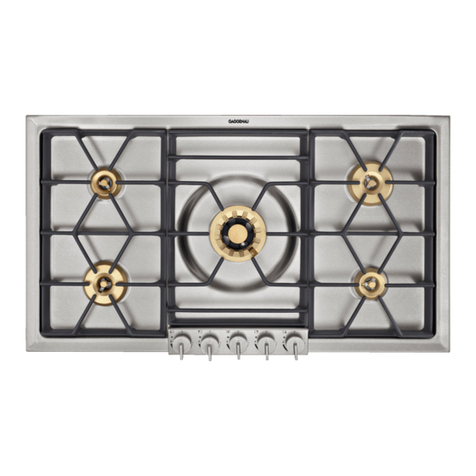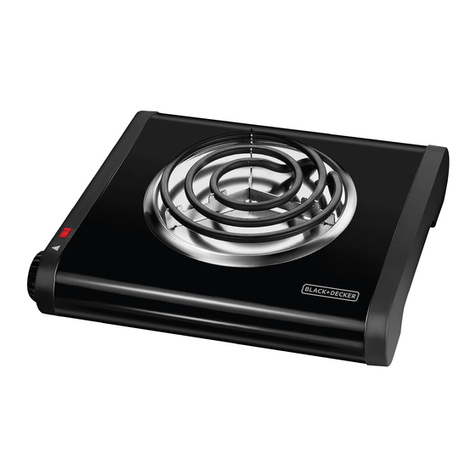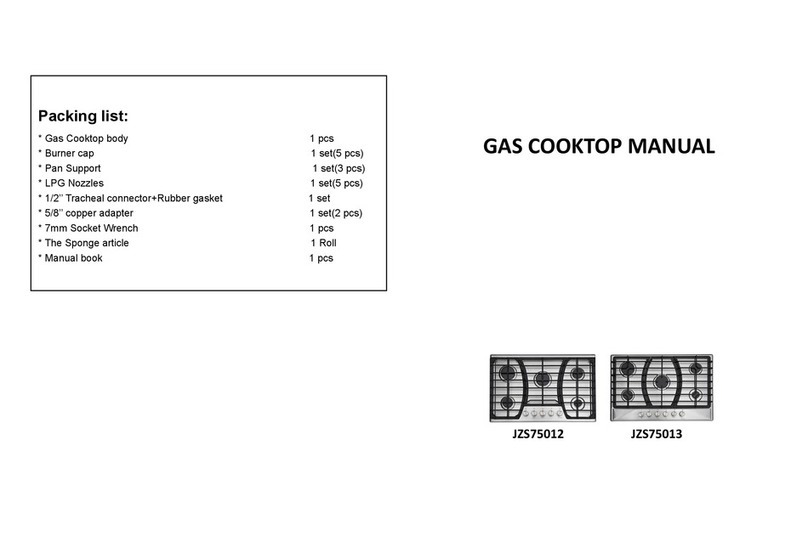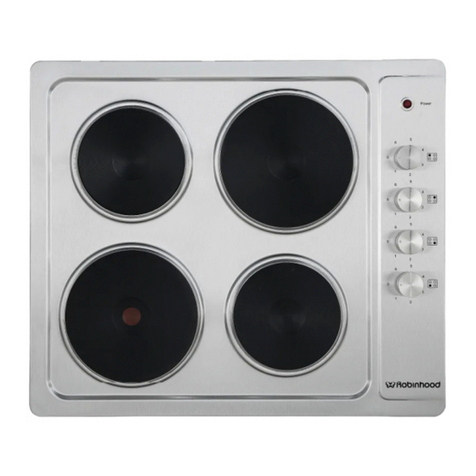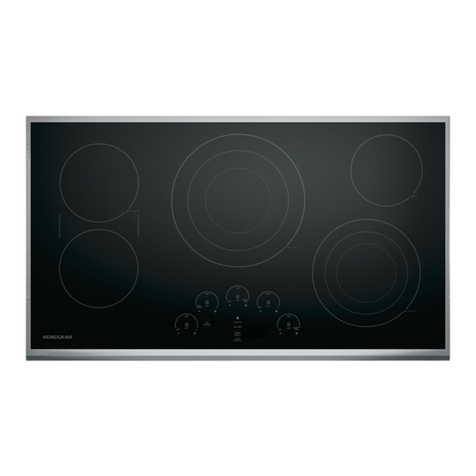St. Croix Auburn Manual

1
Auburn Operations & Maintenance Manual
Auburn
Operation & Maintenance
Manual
Table of Contents
ST. CROIX FEATURES.......................................................................................3
INSTALLATION.................................................................................................. 4
PREVENTING CHIMNEY PROBLEMS.......................................................... 4
SATISFACTORY PERFORMANCE................................................................. 4
APPROVED FUELS .............................................................................................4
Corn
,
Pellets, Wheat, Rye, Cherry Pits & Distiller’s Grain...............4-5
OPERATING INSTRUCTIONS......................................................................... 6
Control Board Features.............................................................................7
Pre-Lighting Instructions..........................................................................8
Lighting Your Stove ................................................................................. 8
Shutting the Stove off ............................................................................... 9
Diagnostic Features....................................................................................9
Safety Features.....................................................................................9-10
Combustion Air Damper ..................................................................10-11
Thermostat Control................................................................................ 12
MAINTAINING THE STOVE ..........................................................................12
Clinker Removal ......................................................................................12
Daily Maintenance ........................................................................... 13-16
Periodic Maintenance ...................................................................... 16-18
Yearly Maintenance ............................................................................... 19
SAFE OPERATION........................................................................................... 20
TROUBLESHOOTING AND FAQ............................................................ 21-25
PARTS LAYOUT ..........................................................................................26-27
WARRANTY....................................................................................................... 28
NOTES..................................................................................................................29
608

2
Auburn Operations & Maintenance Manual
Dear St. Croix Corn Stove Owner:
Congratulations! Your purchase of a St. Croix corn stove places you among a
select group of individuals who have demonstrated their concern about residential
heating efficiency and our environment.
This owner's manual is designed to help you obtain maximum benefit from your
St. Croix corn stove.
Please read this manual in its entirety BEFORE operating your corn stove. During
the manufacturing process every effort has been expended to ensure that each St.
Croix corn stove meets the highest quality standards of material and workmanship.
Here are some important aspects of corn stove installation and operation which
you must observe in order to obtain maximum comfort and safety from your new
St. Croix corn stove.
1. Have your new St. Croix corn stove installed by trained, qualified personnel.
2. Use only clean, dry quality corn for optimum performance in your St. Croix corn
stove.
3. Faithfully adhere to the maintenance program described in this manual. Thank you
for selecting a St. Croix corn stove as the environmentally preferred answer to
your residential heating needs.

3
Auburn Operations & Maintenance Manual
Large Ash Pan Area
With Quick Release Latches
Auburn
Features
Figure 1
Tube
Scraper
Rod
Coal Rake
Rod
Slide-out
Bottom Rod
User Friendly
Digital
Control Board
With Diagnostic
Features
Slide Track
To hide Controls
Behind stove
Thermostatic
Control Option
Available
Patent Pending
Burn System
Huge 90 Lbs. Hopper

4
Auburn Operations & Maintenance Manual
Operation and Maintenance
Auburn corn Stove
CAUTION: Operate this unit only with the fuel hopper lid closed. Failure to do so may result in
emission of products of combustion from the hopper under certain conditions. Maintain hopper
seal in good condition
INSTALLATION
Proper installation is essential for safety,
effective operation, warranty coverage,
insurance requirements and to meet local
building codes. Installation requirements are
described in the Installation Manual included
with your new stove.
PREVENTING CHIMNEY PROBLEMS
When burning corn care should be taken in
how the venting system is installed. To burn
corn the moisture content should be 15% or
less. This is much higher that the moisture
content of wood pellets and can result in
condensation forming in the venting system
in certain installations. The chimney system
should stay within the warm envelope of the
house as much as possible. Only penetrate
the exterior of the home where the exhaust
system will terminate. Remember
condensation from a corn stove is
detrimental to the venting system. Only
buy venting systems that are warranted
when burning corn.
The chimney and chimney connector should
be inspected at least once every two months
during the heating season to prevent the
system from getting plugged with Fly ash.
Clean the exhaust system if needed. Use of
an appropriately sized chimney brush or the
Services of a Professional chimney sweep are
recommended.
APPROVED FUELS
SHELLED CORN
Shelled corn must be 15% or less moisture
content. The keys to satisfactory performance
are: proper operation of the stove, diligent
maintenance and burning only dry, clean, quality
corn. Corn dust must be screened prior to using.
NOTE: Corn with excessive grain dust must be
screened, by sifting with 3/16" mesh screening.
Large pieces of cob may plug the auger.
Clinkers and ash are a by-product of burning corn
and are not caused by your stove. Stove performance
can be quickly and severely reduced if poor quality
corn is used. Contact your dealer for more informa-
tion on where to get high quality corn to burn in
your new corn stove.
Store corn in a tight container use other methods to
ensure they do not become rain soaked or absorb
moisture from damp or wet floors. This will also
prevent rodents from becoming a problem. Do not
store corn within stove installation clearances or
within the space required for clinker removal.
The stove is not warranted against damage caused by
poor quality corn, incorrect operation, poor
maintenance or incorrect installation.
SAVE THIS OPERATIONS AND
MAINTENANCE MANUAL

5
Auburn Operations & Maintenance Manual
Pellets
St. Croix Corn stoves come equipped with
a burn pot installed that has removable
side shields.
When burning pellets or any other fuels
mixed with pellets, the side shields must be
removed. Failure to remove the side shields
will prevent fuel from spilling into the ashpan
in the event the pot overloads. See figure 2
below showing the removal of the side
shields. The shields lift up and are removed
without needing any tools.
Figure 2
Cherry pits
When burning cherry pits or any other fuels
mixed with cherry pits, the side shields must
be removed. Failure to remove the side
shields will prevent fuel from spilling into the
ashpan in the event the pot overloads.
Distiller’s Grain pellets
When burning Distiller’s Grain pellets or any
other fuels mixed with Distiller Grain Pellets,
the side shields must be removed. Failure to
remove the side shields will prevent fuel from
spilling into the ashpan in the event the pot
overloads.
Distiller’s Grain is a byproduct of producing
Ethanol and has higher oil content than corn
itself. Due to this the stove may require more
frequent cleaning. Soot may rapidly form in the
exhaust system if the air is not set properly.
Check the exhaust frequently when burning
Distiller’s Grain pellets.
Wheat
Wheat is a small grain and burns in a similar
manner as corn. It forms a clinker in the burnpot
that is tends to stick to the sides of the pot. The
clinker may need to be pushed into the ashpan
using a long narrow screwdriver.
Since Wheat is a small lightweight grain, more
residue will blow out of the burnpot as it burns.
If an excessive amount seems to be blowing out
of the pot, adjust the damper by closing it a
small amount at a time. (Read the section
covering the Combustion Air Damper on page
10 & 11)
Rye
Rye is a small grain and burns in a similar
manner as corn. It forms a clinker in the burnpot
that is tends to stick to the sides of the pot. The
clinker may need to be pushed into the ashpan
using a long narrow screwdriver.
Rye is also a small lightweight grain, more
residue will blow out of the burnpot as it burns.
If an excessive amount seems to be blowing out
of the pot, adjust the damper by closing it a
small amount at a time. (Read the section
covering the Combustion Air Damper on page
10 & 11)

6
Auburn Operations & Maintenance Manual
PREVENTING CHIMNEY FIRES
Chimney fires can be prevented by properly
operating the Stove and by periodic inspection
and cleaning of the chimney. When wood is
burned it produces tar and other organic vapors,
which combine with expelled moisture to form
creosote. The creosote vapors condense in the
relatively cool chimney flue associated with a
slow burning fire. As a result, creosote residue
accumulates on the flue lining. When ignited this
creosote can result in an extremely hot chimney
fire.
The chimney and chimney connector should be
inspected at least once every two months during
the heating season to determine if a creosote
build-up has occurred. If a significant layer of
creosote has accumulated (3 mm or more) it
should be removed to reduce the risk of a
chimney fire. Use of an appropriately sized
chimney brush or the services of a professional
chimney sweep are recommended.
The chimney and chimney connector should be
inspected at least once every two months during
the heating season to prevent the system from
getting plugged with Fly ash. Clean the exhaust
system if needed. Use of an appropriately sized
chimney brush or the Services of a Professional
chimney sweep are recommended.
OPERATING INSTRUCTIONS
A different type of heater. The corn stove is
neither a cordwood stove nor a Stove. Its
operation and maintenance differ from the tra-
ditional wood stove. FOLLOW THESE
OPERATING INSTRUCTIONS EXACTLY AS
STATED TO ENSURE SAFE AND RELIABLE
OPERATION.
1. Carefully read this “Operation and Mainte-
nance” manual in its entirety BEFORE lighting
your stove for the first time.
2. Obtain final inspection and approval of
installation from local building officials.
3. Carefully clean all marks off the gold plated
parts before the first fire is lighted. Use a soft
cloth and a “Windex” type cleaner. Caution:
Never use an abrasive cleaner on any plated or
painted parts of the stove.
4. Have your dealer demonstrate all the operational
and maintenance steps necessary for proper use of
the stove. Sign and return the warranty card, to the
address listed on the back page.
5. Some odors may be given off during the first few
hours of burning during initial break-in. These odors
are normal and not harmful. However, ventilating
the room until the odors disappear is recommended.
6. The stove will become HOT while in operation.
Keep children, clothing and furniture away from all
stove surfaces.
WARNING: Direct contact with the stove while
operating may cause skin burns.
7. To avoid the possibility of smoke and/or sparks
entering the room always keep firebox and ash pan
doors closed whenever the stove is operating.
8. A certain amount of carbon monoxide may be
produced within the stove as a by-product of
combustion. All exhaust vent connections must be
sealed with RTV silicone to assure a gas tight seal.
Any leaks into a confined area caused by faulty
installation or improper operation of the stove could
produce dizziness, nausea and in extreme cases,
death.
9. An outside source of combustion air is required
on all mobile home installations. If room air is used
to supply combustion air, room air starvation,
operation of exhaust fans and icing of air vents can
adversely affect proper stove operation. If these
conditions exist, outside air should be used.
10. Smoke detectors, installed in the same general
area as the stove, may be activated if the stove door
is left open and smoke is allowed to enter the area.
READ “FREQUENTLY ASKED QUESTIONS”
ON PAGES 21 – 25 BEFORE OPERATING
THE STOVE.

7
Auburn Operations & Maintenance Manual
Control Board Features
The Control Board controls all functions of the
Stove by monitoring sensors that are in the
system. These sensors serve 2 purposes.
a. General Operation of the Stove.
b. Safety Features, to shut the unit down in
the event the sensors detect a problem in
the unit.
The Control Board also has Diagnostic
Capabilities to help in diagnosing 3 areas in the
Stove. These areas are:
1. High Temperature Limit.
2. Proof of Fire Sensor
3. Vacuum in the Firebox
A closer look at the Control Board to the right in
figure 3 will explain how the board works. There
are five buttons labeled 1 through 5, a slide
switch labeled 6 and a LED Light bar with 5 Heat
Settings. The LED Light bar is also used during
the Diagnostic process, see page 9 for more
details.
The buttons on the board function as follows:
(Refer to Figure 3. The touch pad buttons and
Slide Switch are labeled with the white numbers 1
through 6)
1. The Heat Level button (1) will advance the
setting between level 1 and 5. Once you reach
level 5, it will drop back to level 1. Each level has
a LED light to indicate where the board is set.
2. The On/Off button (2) turns the Stove On
and Off. It will also reset the board after the
board has sensed a problem and is flashing a
Diagnostic code.
3. The auger button (3) will allow the customer
to manually auger corn into the burn pot on start
up when needed. This is particularly helpful in
priming the Auger Tube when it is empty.
4. The Draft Trim button (4) allows for adjusting
the Exhaust fan voltage on Heat Level 1 only. Push
the button and the all of the LED Lights in the light
bar will flash once. This decreases the draft fan
voltage approximately 5 volts below the default
setting. Push the button a second time and all of the
LED Lights in the light bar will flash twice. This
decreases the voltage approximately another 5 volts.
Pushing the button a 3
r
time will reset the voltage to
the default setting. This adjustment is available to
fine tune the #1 Heat Level draft setting. This would
only be used in the case the Stove was hooked up to
a tall Vertical Chimney (see point 11 on page 24 for
more information)
Figure 3
5. The Feed Trim button (5) will allow the Fuel
feed rate to be adjusted on Heat Level 1 only. Heat
Level 1 should be seen as the Pilot setting of the
Stove, when operating on a Thermostat. Pushing the
Feed Trim button (5) will switch between the
different adjustments. Heat Level one can be
adjusted in the following ways:

8
Auburn Operations & Maintenance Manual
a. The first LED only indicates the Normal
#1 setting. (1.5 second on time). This is
the default setting.
b. The first and fourth LED lights indicate
the #1 Low setting. (1.25 second on time)
This will reduce the heat output on the #1
setting. This setting will also create more
buildup on the glass. (see point 10 on
page 23)
c. The first and fifth LED lights indicate the
#1 High setting. (1.75 second on time)
This will produce the most heat available
on the #1 setting. This is helpful in
keeping the glass a little cleaner when
burning on low.
The adjustments described in points 4 and 5
remain in effect as long as the unit is plugged
in. If the unit gets unplugged or if there is a
power failure the settings are lost and the
adjustments would need to be reset.
6. Thermostat Slide Switch. Use this switch to
change the Operations mode from a Manual
Mode to Thermostat Mode.
Pre-Lighting Instructions
When lighting your stove for the first time or any
time you have run out of corn you will need to fill
the hopper with corn. Corn is fed from the hopper
to the burn pot by an auger. A high torque motor
that is capable of doing SERIOUS harm to
fingers drives the auger. Keep fingers and other
objects away from the auger.
WARNING: The Auger can start at any time
while the stove is running
CAUTION: The Coal Rake must be pulled out
and the Slide-Bottom pushed in to operate the
stove. (See Figure 1, Stove Layout on page 3)
WARNING: The Fire Door and Ash Pan
Doors must be in the latched position during
normal operation.
Lighting Your Stove.
1. Make sure there is corn in the hopper.
2. Add one cup of Pellets to the burn pot (not
more and not less). Do not try to start your stove
with corn; Corn is difficult to start. Add a generous
amount of starter gel to the pellets.
3. This next item is optional, but it will give an
immediate boost to the start up procedure. Crumple
up half of a newspaper page, light the gel and toss
the paper in the burn pot.
4. Close the door and push the On/Off button on
the control board. (Button #2, see figure 3)
At this point all that needs to be done is to monitor
the burn pot to make sure the stove starts up
properly. Once the On/Off button has been pushed
the Start Up program takes over.
The Start up Program works as follows:
a. The Combustion Fan comes on at high
speed and the control board checks to make
sure the Vacuum switch locks in. (See
section on Diagnostic features on page 9)
b. When the Control Board senses the Vacuum
switch the Exhaust Fan drops to a lower start
up speed until the Proof of Fire Switch locks
in.
c. After 5 minutes the board checks for “Proof
of Fire” and automatically starts feeding
corn on the #1 setting. If the board senses
P.O.F. then the stove has started
successfully.
d. If the board fails to sense P.O.F. after 5
minutes it will repeat the last step and
continue feeding corn on the #1 setting for 5
more minutes.
e. The board will check for P.O.F. again. If the
board still fails to sense the Proof of Fire
switch the stove will go into “Safety
shutdown” (See section on Diagnostic
Features on page 9).
If stove fails to start, repeat steps 2 through 4 from
the section on Lighting Your Stove.
CAUTION: NEVER ADD FIRE STARTER TO
A HOT STOVE.

9
Auburn Operations & Maintenance Manual
Shutting The Stove Off (Refer to Figure 3)
1. Press the On/Off switch (2) once; the lights
will go off and the fire will go out in a few
minutes. The board essentially goes into “Safety
shutdown”.
2. As long as the Exhaust Temperature within
the stove remains above 110°F, the Room Air
Fan and the Combustion Exhaust Fan will
continue to run. Once the P.O.F. switch drops out
the Combustion Fan will run for another 10
minutes and finally the stove will shut down
completely.
3. NEVER unplug the stove to shut it off. Doing
so may cause a significant amount of smoke to
enter the room.
Diagnostic Features of the Control Board
The #2 LED and the #3 LED lights on the LED
Light bar as show in Figure 3 will flash to give a
diagnostic code to help in diagnosing problems
that may occur.
These conditions fall into 2 categories:
a. Heat related issues.
b. Vacuum related issues.
The Diagnostic Lights flash as follows:
1. The Proof of Fire switch. This switch
will sense the temperature of the Exhaust
rising during start up. If the Exhaust
temperature does not reach 110 degrees
F, or if during use the temperature drops
below 110 degrees F, the Stove will go
into “Internal Alarm” and the Auger
will quit feeding fuel. Once the stove
completes the safety shutdown, the #3
LED will start blinking. (See Figure 3 on
Page 7 and point 5 on page 22)
2. The High Limit switch. This sensor will
sense if the unit reaches temperatures that
are too high for normal operation. If this
happens the Auger will quit feeding and
the #2 and #3 LED lights will flash
simultaneously. (See Figure 3 on Page 7
and point 6 on page 22)
3. The Vacuum Switch - For the stove to
operate, the Firebox needs to be sealed.
During the first 30 seconds after the stove
has been turned on the Control Board will
check if the switch senses negative pressure
(Vacuum) in the Firebox of the stove. If
there is no negative pressure, the stove will
shut down and the #2 LED will start
blinking. (See Figure 3 on Page 7 and point
4 on page 21).
“Power Reset”. If the board becomes unresponsive
you must unplug the stove, wait 10 seconds and plug
the stove back in to reset the board.
“Internal Alarm”. When the control board becomes
unresponsive, the control board is in Internal Alarm.
The control board has sensed one of the Safety
sensors. This may cause the stove to go out. In some
cases, after waiting approximately 45 seconds the
stove will start responding to the control board
again. Many times, the cause of this is a change in
the vacuum inside the stove. This may be caused by
excessive wind, opening the Firebox door or
opening the Ash Pan door. The control board will
monitor the vacuum switch and resume normal
operation if the vacuum returns to normal.
Safety Features
1. ”High Limit” switch”, an overheat safety
switch will shut off the fuel feed if the Stove
reaches temperatures above normal
operating temperature. This is a “Normally
Closed” switch and is part of the Fan limit
control. If the High limit switch trips several
times, the problem in the Stove must be
diagnosed before the Stove is put back in
service, (Defective Room Fan, dirty Room
Fan, dirty Return Air Filter, defective Fan
Limit Control or possibly a bad Control
Board)
2. Proof of Fire switch also called the P.O.F.
This senses the temperature rise in the
exhaust system. The switch is “Normally
Open” and closes the circuit at 110 degrees.
The Stove will shut down if temperatures
above 110 degrees F are not sensed during
start up or if the temperature drops below
110 degrees during normal operation.

10
Auburn Operations & Maintenance Manual
WARNING: These safet
y
features are
desi
g
ned to protect life and propert
y
.
B
y
passin
g
these features voids all warranties
and the safety listing of the stove.
3. Vacuum switch also called the Negative
pressure switch. When the stove is
turned on the Exhaust fan will create a
negative pressure in the firebox. The
control board continually checks to see if
Negative Pressure (vacuum) is present
during operation of the Stove. If the
exhaust venting system becomes clogged
or obstructed, the firebox door or ash pan
door are left open or the exhaust fan quits
working the control board will go into
“Safety shutdown”. There is a 60 second
window to allow for cleaning the glass
and removing the clinker before then
Stove shuts down. This is sufficient for
the Daily Maintenance
The St. Croix corn Stove has been Safety
Tested by an accredited, independent
laboratory.
Combustion Air Damper
Figure 4
Your stove is equipped with an air inlet
damper. (See Figure 4) This is one of the most
important areas of setting up your stove to burn
corn.
Adjusting the Damper may take a little time and
patience, but only needs to be done once. After the
damper has been adjusted for the unique installation
in your home the control board will do the rest.
The purpose of this damper is to adjust combustion
airflow to match the characteristic of each specific
air inlet and chimney configuration. The damper is
preset at the factory with a setscrew. The damper
will most likely only need s small adjustment during
the break in period. To know if the damper needs to
be adjusted you should learn to recognize how the
corn burns in the St. Croix corn burning system. The
burn pot should be “BALANCED”. What this
means is the corn that is being augered into the burn
pot rapidly turns into glowing coals. If you see a lot
of unburned corn in the pot an adjustment may be
needed. In an unbalanced pot the corn will quickly
stick together and prevent the proper flow of
combustion air. The pot will overload and the fire
will go out. Once the damper is adjusted for your
installation, it should not be necessary to make any
further adjustments to the damper. The combustion
air is automatically increased every time the feed
rate is advanced on the control board. Adjusting the
damper should be done during Break-in. This
requires the burning of 15 bags of corn or
continuous burn for two weeks.
Figure 5
If you experience problems adjusting the stove
during the Break-In Period, contact your dealer.
THERMOSTAT
WIRE
TERMINAL
DAMPER

11
Auburn Operations & Maintenance Manual
Terminology used in the Damper Adjustment
1. Balanced burn pot. This means the corn
rapidly turns into red-hot coals once it is in
the burn pot.
2. Lag time. This is the time it takes for the
corn to start burning and the burn pot to
become balanced. Corn will tend to stick
together in a clump in the burn pot if the corn
feeds in faster than it’s burning.
3. Overloaded burn pot. Once the corn has
formed a clump in the burn pot the pot will
overload and slowly the fire will die out.
Procedure for adjusting the damper:
As was stated earlier there is a setscrew in the
damper and the damper has been preset at the
factory. This setting will most likely work for
90% of the most common installations. Long
horizontal runs might need the damper opened.
Tall vertical runs might need the damper to be
closed a little, etc. To adjust the damper, use the
setscrew to make the adjustments. To make an
adjustment turn the screw ½ turn clockwise to
open the damper or ½ turn counter clockwise to
close the damper. Remember to use the damper
handle to bring the damper up to the screw. The
damper will not close by itself. After making an
adjustment wait at least 15 minutes to see how
the burn pot reacts to the change.
a. Once the stove is burning, leave the
control board on the #1 setting for ½ an
hour. This will allow the stove to warm
up before any adjustments to the damper
are made. After ½ an hour look in the
burn pot to see if the burn pot is
balanced. Unless there weren’t enough
coals in the pot, when the corn started
augering into the pot on start up, the
stove should be burning fine and an
adjustment is not needed.
b. Advance the heat setting to #2 and let the
stove burn at this setting for ½ an hour.
Check the burn pot to see if it is
balanced. Most likely the stove will be
burning fine at this point, because the
damper was preset at the factory.
c. Advance the heat setting to #3 and let the
stove burn at this setting for ½ an hour.
Check the burn pot to see if it is balanced.
Remember: Look at the coals in the pot, not
at what the flame looks like. Most likely the
damper will not need to be adjusted.
d. Advance the heat setting to #4 and let the
stove burn at this setting for ½ an hour.
Check to see if the pot is balanced. This is
where a damper adjustment might need to
be made. As the heat setting reaches the
higher settings the “Lag time” can become
too long if the air isn’t adjusted correctly. If
you notice that the coals are being covered
up with unburned corn, adjust the damper to
give it more air. Remember: Only turn the
setscrew one ½ turn clockwise to open the
damper (You might need to use a
screwdriver to break up the clump of corn in
the burn pot to allow for proper airflow).
Wait 15 minutes to see if the burn pot
becomes balanced. Repeat this step as many
times as needed until the burn pot becomes
balanced.
e. Advance the heat setting to #5 and let the
stove burn at this setting for ½ an hour.
Check the burn pot to see if it is balanced A
small damper adjustment might need to be
made at this time to make sure the “Lag
time” isn’t too long. Remember: Only turn
the setscrew one1/2 turn clockwise to open
the damper. Wait 15 minutes to see if the
burn pot becomes balanced. Repeat this step
as many times as needed until the burn pot
becomes balanced.
If the stove has been connected to an existing
Chimney system that has good Natural Draft, the
procedure mentioned in the points dand eabove
may actually require that the damper gets closed
slightly instead of opened to compensate for the
additional draft in the chimney system.
This process will take about 3 hours, but it only
needs to be done once at the initial burn. This will
adjust the stove to the unique circumstances of your
home.

12
Auburn Operations & Maintenance Manual
Thermostat Control - Most multi-fuel stoves
aren’t capable of using a thermostat. This is due
to the fact that many fuels do not react very well
to sudden increases in the feed rate. A stove that
goes from a #1 setting to a #5 setting will almost
always have problems making that transition. The
burn pot will overload and the fire will go out.
The St. Croix corn stove uses a simple time delay
between each Heat setting to allow the stove to
react to the increase in corn. This allows the stove
to function very well on a thermostat. A Milivolt
type thermostat will work with this control board.
The stove is not fully automatic when running
on a thermostat, when the thermostat is not
calling for heat the stove will drop to the low
(#1) setting as a pilot. For location to connect
the thermostat wires see Figure 4 on page 10.
MAINTENANCE OF THE STOVE
The St. Croix corn clinker theory - And why
we do what we do.
Many manufacturers of multi-fuel stoves use
complicated stirring mechanisms to break up the
clinker in the burn pot. We feel that is a
mistake.
Most grains do not burn as well when it is
disturbed in the burn pot. Corn, wheat, rye &
distiller’s grain pellets need high temperatures
and proper airflow in the burn pot to burn
properly. That energy is stored in the clinker that
is being formed in the burn pot. It glows red-hot
and provides the heat needed to ignite the corn
that is being fed into the burn pot. When the
clinker is broken up, that constant source of
energy is lost, and now it becomes more difficult
to burn grain. When grain is not burning properly
it tends to stick together and form a clump in the
burn pot. It is impossible for air to flow through
this clump and soon the pot will overload and the
fire goes out.
This is where some manufacturers use the stirring
mechanism to break up the clump of fuel to
maintain proper airflow and others use large burn
pots to handle this problem (Smaller burn pots
are better). The truth is neither is needed. The St.
Croix burn system allows grains to be burned
efficiently and completely in a relatively small
burn pot.
Clinker Removal.
Once a clinker has formed in the burn pot, the
problem is how to get rid of it. The St. Croix Burn
system is designed to be able to remove the clinker
without loosing the fire in the burn pot. It is a 3-part
system.
1. The coal rake. This is a “fork” shaped
device that will allow the stove operator to
separate the burning coals from the top of
the clinker.
2. The slide out bottom. This allows the bottom
to be pulled out so the clinker can drop out
of the bottom of the burn pot.
3. The program on the control board. To drop
the clinker you set the board on the #1
setting for a couple of seconds and then
return the stove to the desired setting. This
starts a time delay in the program to allow
the clinker to be removed, the coals to be
dropped to the bottom of the pot and the
Burn pot to become balanced again before
the board resumes on the setting of you
choice.
NOTE: FAILURE TO KEEP YOUR STOVE
CLEAN, AS DESCRIBED IN THIS MANUAL,
COULD RESULT IN POOR OPERATION,
INEFFICIENT FUEL USAGE AND A
POSSIBLE SAFETY HAZARD! IT IS YOUR
RESPONSIBILITY TO DETERMINE
NEEDED MAINTENANCE FREQUENCY.
CAUTION: THE DOOR AND FRONT PART OF
THE STOVE WILL BE HOT. DO NOT TOUCH
ANY PART OF THE STOVE THAT IS HOT!
This stove requires a minimum amount of daily
maintenance. Required maintenance depends
largely upon the quality of fuel burned and the
rate of burn. The amount of daily maintenance
will increase if fuel quality decreases and/or the
burn rate increases. The operator of the stove is
responsible for determining the frequency of
cleaning the stove.

13
Auburn Operations & Maintenance Manual
Daily Maintenance
Example of Schedule for dropping Clinkers from the burn pot: This may be
required more than once a day, depending on the burn rate of the stove and the quality of
fuel used. Check the stove frequently at first to establish a Maintenance Schedule
for cleaning the burnpot. If Clinker is not removed, the burnpot will overload and
fuel will spill into the Ashpan.
1 - Continuous burning of the stove on the Low burn setting (Pilot) – Approximately
every 48 hours. This may vary depending on the quality of fuel used.
2 - Continuous burning of the stove at the High burn setting (#5) – Approximately
every 18 hours. This may vary depending on the quality of fuel used.
The Daily Maintenance will focus on 4 areas in the stove: removing the Clinkers from
the Ash Pan (if needed), dropping the Clinker from the Burnpot, cleaning the Heat
Exchange Tubes and cleaning the Glass. A break down of this process consists of these
steps:
Note the position of the Coal Rake Rod and the Slide-out Pot Bottom Rod during
normal operation!!
Normal Operation
Figure 6

14
Auburn Operations & Maintenance Manual
How to drop the Clinker from the Pot
1. The coal Rake. The first step is to push the coal rake in and shave the burning
coals and corn off the top of the clinker. Once this is done open the door and add
a ¼ cup of pellets on top of the coals (See figure 7 below). To push in the Coal
rake, use the Rod Handle tool shown in figure 9 on page 16.
Figure 7
2. The ash pan. Make sure the Ashpan is not too full to receive a clinker. If the
Ashpan is too full, the clinker may not drop all the way through. This will not
allow the pot bottom to be closed. If this happens, empty the Ashpan and restart
the stove.
3.
The slide out bottom. (See figure 8 on page 15) Now you are ready to drop the
clinker from the burn pot. Pull the bottom out in one quick motion and let the
clinker drop into the ash pan. Quickly push the bottom in again. To pull out the
slide bottom use the Rod Handle tool shown in figure 9 on page 16 (see point 2
at the top of page 16).

15
Auburn Operations & Maintenance Manual
Figure 8
4. The control board. Set the heat setting to #1 for a few seconds and return to the
setting it was on. This initiates a time delay for dropping the clinker.
5. Dropping the coals back into the burn pot. At this time pull the coal rake back
out of the burn pot to drop the coals in the pot. See position of Coal Rake & Pot
Bottom in figure 6 on page 13 for normal operation.
The time delay in the program will allow a smooth transition back to where the stove
was burning before the clinker was dropped.
6. Cleaning the Heat exchange tubes. Now you can pull the tube scraper back and
forth a couple of times to keep the tubes clean. If the Tube Scraper feels sticky
and difficult to move, check for the presence of creosote on the tubes. If creosote
is present a damper adjustment may be needed or the Stove has become plugged
and needs a thorough cleaning. Call Dealer for assistance. To pull the tube
scraper back and forth use the Rod Handle tool shown in Fig. 9 on page 16.
7. Use a dry paper towel to clean the glass. Quickly open the door and wipe the
glass. The rate of burn will determine how often the window needs cleaning.
Prolonged burning at a slow burn rate will result in the need for more frequent
window cleaning. Cooling the Stove and wiping the window daily with a cloth or
paper towel will normally keep the window from accumulating difficult to clean
residue. Use of a glass cleaner ONLY permitted when the Stove is cold.
CAUTION: Do not slam the door. Do not operate the Stove with a broken or cracked
glass. Replace only with heat resistant ceramic glass supplied by the manufacturer.

16
Auburn Operations & Maintenance Manual
There are 2 things to keep an eye on during the cleaning process.
1. If the ash pan door or firebox door were left open for more than 60 seconds the
Stove will go into safety shutdown. You will notice that the Stove quits augering
corn into the burn pot. Toggle the On/Off switch off and back on. This will reset the
board. You will need to use the auger button (#3) to manually feed corn into the pot
for a couple of minutes until the program resumes.
2. If the stove has been running for an extended period of time on the #5 setting, the
clinker will sometimes stick to the burn pot. If that happens, pull the coal rake back
out. Open the door and use a long screwdriver and give the clinker a couple nudges
in the pot. (Make sure the burnpot bottom is closed when you do this or you will lose
the coals with the clinker) Then repeat the steps for dropping the clinker.
Remember: The coal rake must be pulled out and the slide bottom pushed in
during normal operation of the stove. (See figure 6 on page 13)
Remember: The fire door and ash pan doors must be in the latched position
during normal operation of the Stove. (See stove layout in figure 1 on page 3)
Periodic Maintenance
CAUTION: Periodic maintenance should only be done while the Stove is shut off and
cold.
1. Ashpan. Empty the ash pan when it
appears full (approximately once a
week). The frequency of cleaning
the ash pan will depend on the
quality and amount of Corn/Pellets
being used. Carefully check to make
sure the ash pan door is tightly
closed after each opening.
2.
Burnpot and Slide-Out Bottom.
Clean burn grate holes whenever
needed. Remove the Burnpot and
use a small metal object (Nail, Drill
Bit, etc) to clean out plugged holes.
(See Figure 9 & 10)
Figure 9
Burnpot & Slide-out Bottom Removal

17
Auburn Operations & Maintenance Manual
Figure 10
To remove the Burnpot from the stove, the Coal Rake must be pulled back so the pot
will clear it. Open the Firebox door of the stove and you will see 2 Hex head screws.
Follow steps 1 through 4 in figure 8 to remove the Burnpot from the stove. To remove
the Slide-out Bottom follow steps 1 and 2 shown in figure 10.
3. Clean-Out Ports/Ash Traps. The stove has 3 Exhaust Cleanout Ports located in the
LEFT AND RIGHT lower corners of the firebox and a 3
rd
clean-out is located
behind the Ash Pan. Left Cleanout/Ash Trap Cover shown in figure 10. Remove
covers and clean with a vacuum regularly.
Frequency of cleaning depends on the amount of fuel being burnt and the quality of the
Corn. Failure to clean the Ash Traps will cause the Stove to become plugged with
Fly Ash.
4. Heat Exchange Baffle. Remove the baffle and clean the ashes that accumulate on a
regular basis. Once a month or sooner, depending on the quality of fuel being used
(See Figure 11 on Page 18)
Figure 10 shows how the baffle is removed from the Stove. Clean the baffle on a regular
basis. Frequency of cleaning depends on amount of fuel being burnt and the quality of
the corn. Failure to clean the Baffle can cause the stove to become plugged with Fly
Ash.
Third Ash Trap/Clean-out Cover is
located behind the Ash Pan

18
Auburn Operations & Maintenance Manual
Baffle Removal
Figure 11
To remove the baffle, lift the back of the baffle up to clear the inner back of the stove and
slide towards the front of the Stove. The baffle will slide out of the keyhole slots and drop
down. When putting the baffle back in the stove, make sure the tabs are in the keyhole
slots and the back of the baffle is lifted up over the inner back to keep the Baffle locked in
place.
5. Exhaust System. Periodic cleaning of the exhaust system is required. Under certain
conditions chimneys may plug up rapidly. Dirty/High moisture content fuel and poor
installations require more frequent chimney cleanings. See Page 6 “Preventing
Chimney Fires”, if burning pellets. The products of combustion will also contain small
particles of fly ash. The fly ash will collect in the exhaust vent and restrict the flow of
the flue gases. Judge the frequency of cleaning by checking the amount of ash that
accumulates in the elbows or tee’s of the exhaust system. Ask the dealer for suggested
frequency of cleaning, equipment needed and procedures for cleaning. Check the
Exhaust system and Ash Traps at least once every two months during the heating
season.
6. Gaskets. Periodically inspect the condition of the rope gasket around the door,
window and ash door. Replace as needed.

19
Auburn Operations & Maintenance Manual
Many dealers offer a Service Contract that will cover Yearly Maintenance. Contact your St.
Croix Dealer for assistance in maintaining your stove in top condition.
Yearly Maintenance
Yearly maintenance is designed to assure safe operation, prolong the life of the stove and help
preserve its aesthetic appeal.
1. Spring Shutdown. After the last burn in the spring, cool the stove. Remove all corn from
the hopper and the auger. Thoroughly clean the burn pot, burn pot box, ash pan and ash traps
behind the ash pan. (To locate the ash traps see figure 10 on page 17)
2. The exhaust system should be thoroughly cleaned at least annually. Call your dealer for this
service.
3. The motor/fan area behind the firebox and under the hopper should be vacuumed annually.
NOTE: UNPLUG THE STOVE. Open the access panels of the stove. Carefully clean or vacuum
any dust, cobwebs and household dust. Carefully vacuum around the fan motors. If electrical wires
become disconnected call your dealer for service.
Figure 12
Note: The Vacuum Switch may be removed to allow easier access to the combustion fan
4. The exhaust fan should be removed (may require a new gasket) and cleaned with
compressed air annually. Call dealer for this service. Annual oiling of the motors is not
needed. (See Figure 12)
5. The Convection Blower should be removed and cleaned with compressed air annually.
Annual oiling of the motors is not needed. (See Figure 12)

20
Auburn Operations & Maintenance Manual
Fall Startup.
Prior to lighting the first fire check the outside area around the exhaust and
air intake systems for obstructions. Try all controls to see that they are working prior to
lighting a fire.
SAFE OPERATION.
1.
Disposal of Ashes.
Ashes should be placed in a metal container with a tight
fitting lid. The closed container of ashes should be placed on a non-combustible
floor or on the ground, well away from all combustible materials, pending final
disposal. If the ashes are disposed of burial in soil or otherwise locally dispersed,
they should be retained in the container until all cinders have thoroughly cooled.
2.
Never use Gasoline,
gasoline type lantern fluid. Kerosene, charcoal lighter fluid
or similar liquids to start or “freshen up” a fire in this heater. Keep all such
liquids well away from the heater while it is in use.
3.
Creosote, Soot and Fly Ash:
Formation and Need for Removal. The products of
combustion will contain small particles of Fly Ash. The fly ash will collect in the
venting system and restrict the flow of flue gases. Incomplete combustion, such
as occurs during start-up and shut-down, or incorrect operation of the room
heater will lead to some soot or creosote formation which will collect in the
venting system. The exhaust system should be inspected regularly during the
heating season to determine if creosote buildup has occurred. Check more
frequently at first to determine a schedule for cleaning the venting system based
on individual use of this Corn/Pellet-burning heater. If creosote has accumulated,
it should be removed to reduce the risk of a chimney fire.
4.
Do not Overfire this unit.
Follow all instructions regarding the proper use of
this heater.
CAUTION: The Electrical Components of the stove are not Owner Serviceable.
Call your dealer for proper diagnosis of electrical problems and service to those
components. See Installations Manual for a copy of the Wiring Schematic.
Other manuals for Auburn
2
Table of contents
Popular Cooktop manuals by other brands
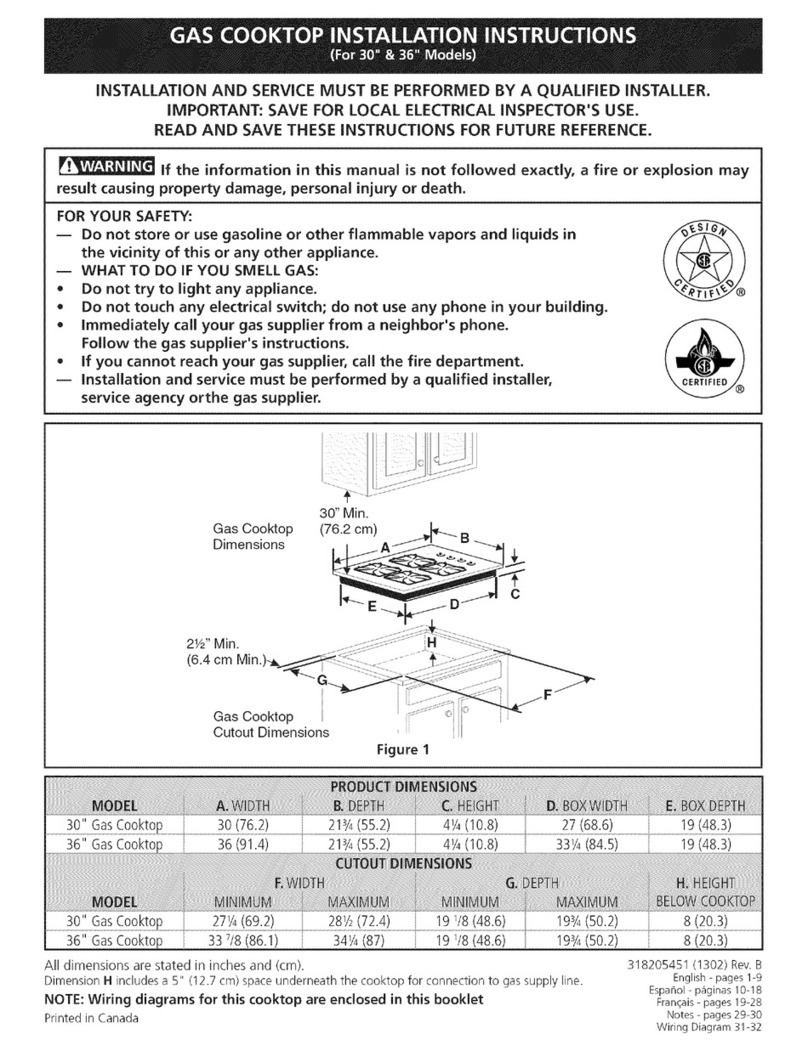
Electrolux
Electrolux E30GC70FSS3 installation instructions
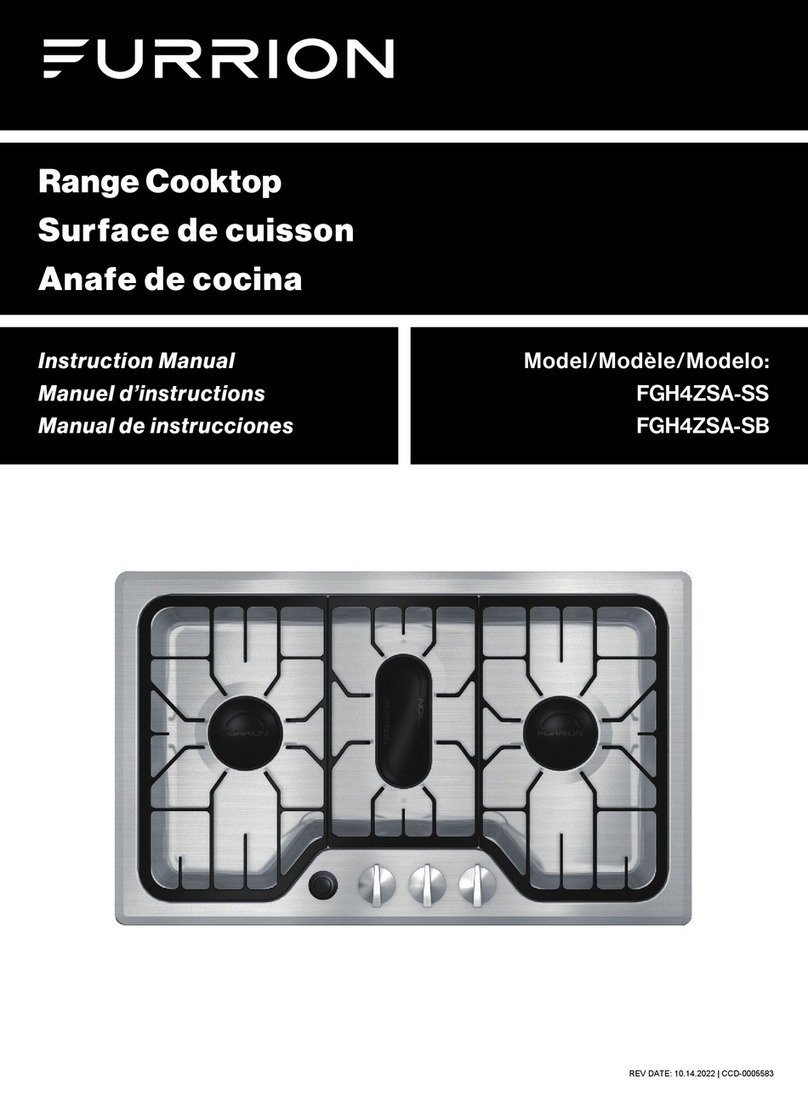
Lippert
Lippert Furrion FGH4ZSA-SS instruction manual
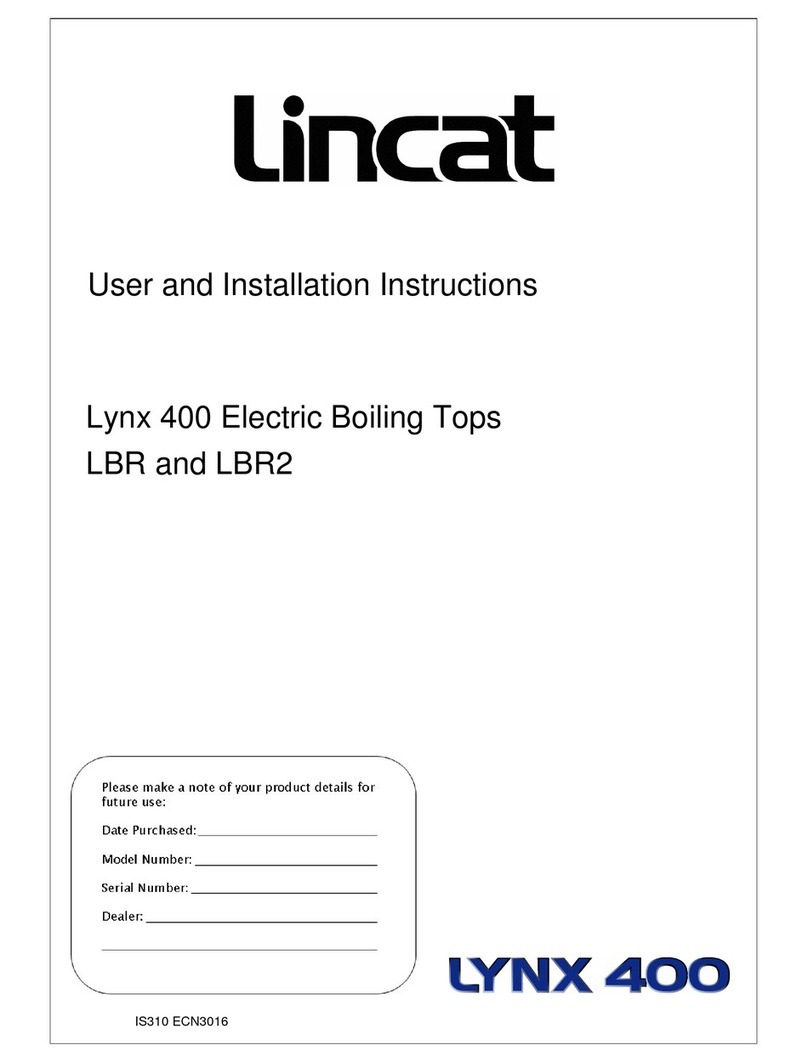
Lincat
Lincat Lynx 400LBR User and installation instructions
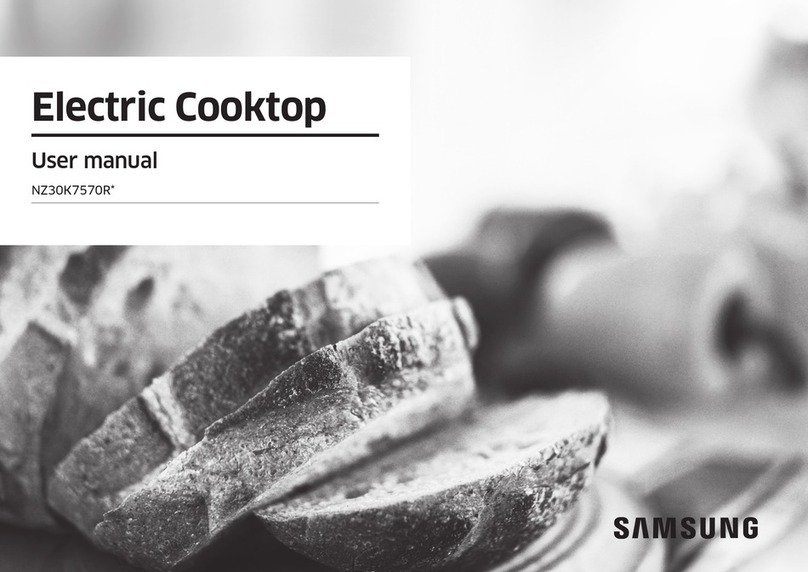
Samsung
Samsung NZ30K7570R SERIES user manual

Nesco
Nesco NC-59502 LAVANO TWIN PRO instruction manual
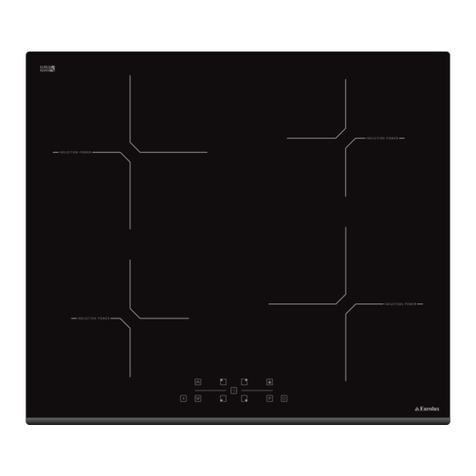
Eurolux
Eurolux EIH6 TC4B FV installation manual
